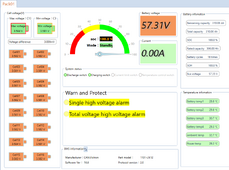Hi,
Is it a physical limitation (degradation) of my cells when they will not charge to more then 57,35V?
The BMS (Seplos 10E) is just in a warning state (single cell and total voltage) so it should just limit charging to 10A, but the battery has been sitting on 57.30-35V for over 2 hours now, not accepting any current.
I have protection limits on 3,65V/cell and 57.6V/total. The balancer is keeping the diffvoltage to 1-3mV. DVCC is set to 57.6V.
What am i missing?

Is it a physical limitation (degradation) of my cells when they will not charge to more then 57,35V?
The BMS (Seplos 10E) is just in a warning state (single cell and total voltage) so it should just limit charging to 10A, but the battery has been sitting on 57.30-35V for over 2 hours now, not accepting any current.
I have protection limits on 3,65V/cell and 57.6V/total. The balancer is keeping the diffvoltage to 1-3mV. DVCC is set to 57.6V.
What am i missing?



